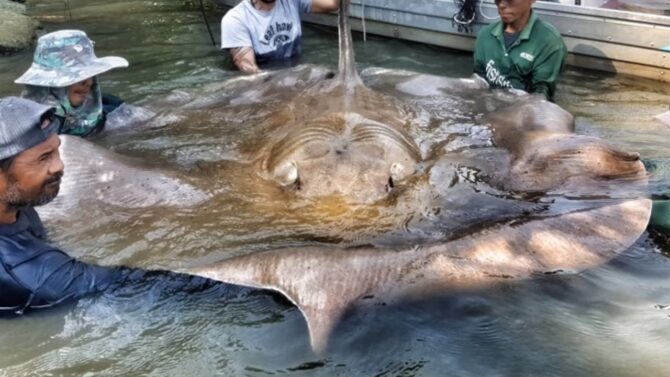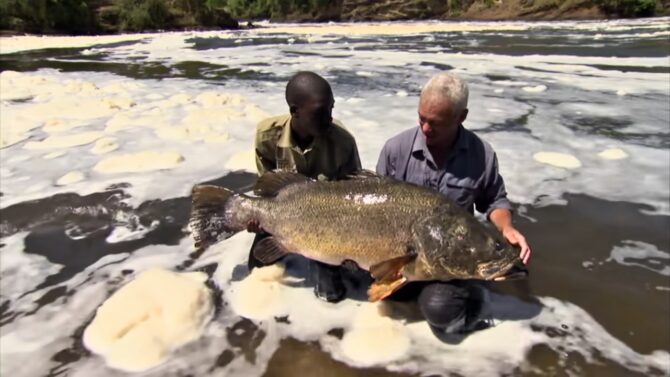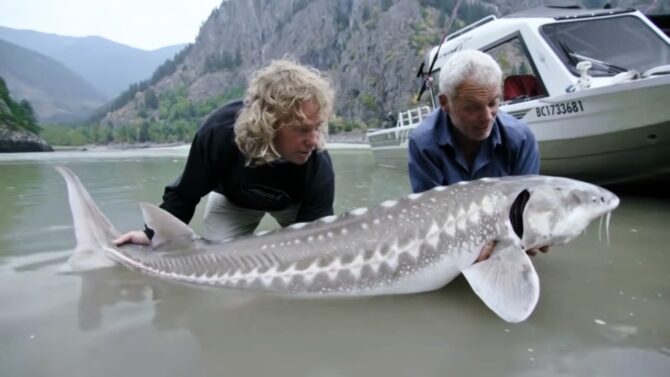Welcome to an adventure that takes you beneath the surface of rivers, lakes, and freshwater habitats around the globe. Today, we’re diving into the world of gigantic freshwater fish. Some of these underwater titans could even give a small boat a run for its money!
From North America to the Amazon and the Mekong Delta, we’re covering the largest, most awe-inspiring freshwater fish species out there. Fasten your seatbelts—or rather, your scuba gear—and let’s get started!
The Criteria for Ranking

Before we dive in, let’s establish the criteria for our rankings. We’re focusing on maximum recorded sizes—both in terms of length and weight. But size isn’t the only thing that matters. We’ll also explore each fish’s habitat, behavior, and unique characteristics. This comprehensive approach will give you a deeper appreciation for these majestic creatures.
So why should you care about the biggest freshwater fishes? Besides their sheer awe-inducing size, many of these fish are critically endangered. Understanding their behaviors and habitats is a vital step in conservation efforts to protect these unique species for future generations to admire.
10. Giant Freshwater Stingray: The Flat Behemoth

Maximum Recorded Size:
- Length: Up to 16.4 feet (including the tail)
- Weight: Up to 1,320 pounds
Last but not least, the Giant Freshwater Stingray is native to Southeast Asia and is known for its enormous size and long, whip-like tail. This bottom-dwelling species is found in large rivers and estuaries. Despite its intimidating size and venomous barb, the Giant Freshwater Stingray is relatively harmless to humans.
It primarily feeds on small fish and invertebrates and is a master at camouflage, often burying itself in sandy or muddy river bottoms. The Giant Freshwater Stingray is currently listed as vulnerable due to habitat loss and overfishing. It is a subject of fascination among marine biologists and conservationists, who are striving to learn more about this elusive giant and how to ensure its survival.
9. Paddlefish: America’s Freshwater Filter Feeder

Maximum Recorded Size:
- Length: Up to 7 feet
- Weight: Up to 198 pounds
Paddlefish are one of North America’s most distinctive freshwater fish species, thanks to their long, paddle-shaped snouts. These filter feeders are primarily found in the Missouri and Mississippi River systems. Paddlefish are another example of a “living fossil,” with a lineage that goes back over 300 million years.
Despite their ancient lineage, they are quite vulnerable to modern-day threats such as dam construction and pollution. Though not as massive as some other species on this list, Paddlefish are nonetheless captivating for their unique appearance and ancient lineage. Conservation efforts are in place to protect this unique species and its important role in North America’s freshwater ecosystems.
8. Taimen: The Siberian River Wolf

Maximum Recorded Size:
- Length: Up to 6.6 feet
- Weight: Up to 231 pounds
Taimen, often called the “River Wolves of Siberia,” are the largest members of the salmon family. These predatory fish are known for their aggressive behavior and are revered by fly fishermen who seek the ultimate freshwater fishing challenge.
Taimen primarily feed on smaller fish, but they’ve been known to eat just about anything that fits in their mouths—including birds and small mammals. They’re a keystone species in their ecosystem, playing a critical role in maintaining the health and balance of Siberian rivers.
Despite their ferocious reputation, Taimen are threatened by overfishing and habitat degradation. Conservation initiatives are underway to protect this unique species and its crucial role in the Siberian ecosystem.
7. Nile Perch: Africa’s Invasive Giant

Maximum Recorded Size:
- Length: Up to 6.6 feet
- Weight: Up to 500 pounds
Originally native to the Congo and Nile River Basins, the Nile Perch was introduced to Lake Victoria in the 1950s. While this species has led to the collapse of native fish populations, it’s also created a booming fishing industry in the region.
The introduction of Nile Perch to Lake Victoria is often cited as a textbook example of the unintended ecological consequences of species introduction. While it has created economic benefits, the environmental cost has been steep.
Due to its large size and predatory behavior, the Nile Perch has fascinated both ecologists and anglers alike. It serves as a stark reminder of the profound impact humans can have on natural ecosystems.
6. Wels Catfish: Europe’s River Monster

Maximum Recorded Size:
- Length: Up to 16 feet
- Weight: Up to 660 pounds
Wels Catfish are native to Eastern Europe but have spread across the continent, finding new habitats in rivers and lakes. They are apex predators and have been known to consume a variety of prey, including fish, rodents, and even birds.
This fish species has become a legend among European anglers, often dubbed the “European River Monster.” Wels Catfish are sought after for sport fishing and are subjects of numerous fishing tales and legends.
Wels Catfish are generally not considered threatened, but local populations can be vulnerable to habitat destruction and pollution. As such, there are ongoing efforts to study these river monsters and ensure their long-term survival.
5. Alligator Gar: The Ancient Predator

Maximum Recorded Size:
- Length: Up to 10 feet
- Weight: Up to 327 pounds
Native to the southern United States, the Alligator Gar is a prehistoric fish species that has been around for over a hundred million years. Its long snout and sharp teeth make it a formidable predator, capable of ambushing prey in both open water and dense vegetation.
Despite its fearsome appearance, the Alligator Gar plays a crucial role in its ecosystem by controlling populations of other fish species. Sadly, this creature is often misunderstood and has been targeted in eradication efforts, leading to a decline in its numbers.
Efforts are now underway to protect and restore Alligator Gar populations. The fish is increasingly recognized for its ecological importance and its role as a living connection to Earth’s distant past.
4. White Sturgeon: North America’s Freshwater Giant

Maximum Recorded Size:
- Length: Up to 20 feet
- Weight: Up to 1,799 pounds
The White Sturgeon is North America’s largest freshwater fish, found primarily in the Columbia River Basin. Its dinosaur-like appearance, complete with rows of bony plates along its body, makes it one of the most striking fish species on this list.
This sturgeon species has adapted to a wide range of habitats, from coastal waters to large inland rivers. It feeds primarily on bottom-dwelling creatures like crustaceans and mollusks. White Sturgeons are popular among anglers for their size and the fight they put up when hooked.
However, they’re also threatened by overfishing and habitat loss. Various conservation programs are in place to restore their populations and preserve this living relic of prehistoric times.
3. Arapaima: The Amazonian Legend
Maximum Recorded Size:
- Length: Up to 15 feet
- Weight: Up to 485 pounds
Hailing from the Amazon River Basin, the Arapaima is often considered one of the most fascinating fish species due to its unique characteristics. It’s an air-breathing fish, which means it can survive in oxygen-depleted waters—a critical adaptation in the ever-changing Amazon environment.
Because of their size and unique biology, Arapaima have been a subject of study for researchers and a target for sport fishermen. Indigenous communities also rely on Arapaima for subsistence, using traditional fishing methods to catch these giants.
The Arapaima holds a place in Amazonian folklore as a majestic creature with mystical powers. Today, it’s a symbol of the rich biodiversity of the Amazon, and conservation efforts are underway to protect this incredible species from the impacts of deforestation and overfishing.
2. Mekong Giant Catfish: The Asian Titan

Maximum Recorded Size:
- Length: Up to 10.5 feet
- Weight: Up to 646 pounds
Found in the Mekong River, this giant catfish holds the record for the largest species of catfish in the world. Native to Southeast Asian countries like Cambodia, Laos, and Thailand, these fish have become symbols of the ecological richness of the Mekong Delta.
As filter feeders, Mekong Giant Catfish consume plankton and are known for their gentle nature. Ironically, these peaceful giants are critically endangered due to habitat loss and overfishing. Conservation organizations are working to protect this species and its vital role in the Mekong ecosystem.
Despite its gentle nature, the sheer size of the Mekong Giant Catfish is enough to startle any unsuspecting fisherman. Tales and folklore surrounding these giants have been passed down through generations, and they continue to captivate the imagination of locals and researchers alike.
1. Beluga Sturgeon: The Caviar King

Maximum Recorded Size:
- Length: Up to 24 feet
- Weight: Up to 3,463 pounds
The Beluga Sturgeon holds the title for the largest freshwater fish in the world. This behemoth is native to the Caspian and Black Sea basins, but its populations have severely declined due to overfishing, especially for its prized caviar.
A single female Beluga Sturgeon can carry several hundred pounds of eggs, which are then turned into the world’s most expensive caviar. Beluga Sturgeon can live for over 100 years, growing throughout their lifetimes. They have a slow reproductive rate, which exacerbates the impact of overfishing on their populations. International efforts are ongoing to regulate the caviar trade and encourage sustainable fishing practices.
The sheer size and longevity of the Beluga Sturgeon make it a subject of awe and fascination. If you ever find yourself cruising along the waters where they live, keep an eye out for a fish that could easily dwarf a full-grown human—or even a small car!
FAQs
What is the largest freshwater fish ever caught?
The largest freshwater fish ever caught is the Mekong Giant Catfish, with a record weight of 645 lbs and 15 oz. It was caught in the Mekong River system in Thailand.
What is the Salween Rita Catfish?
The Salween Rita Catfish is a rare species of catfish that has been caught with a record weight of 308.85 pounds. It is deeply gray in coloration and is scaleless with a broad body and head.
What is the Irrawaddy Mystus?
The Irrawaddy Mystus is a giant catfish that holds a rod-and-reel record of 115 pounds. It is generally caught amid tree roots and deep rocky structures during high water months.
What is the Jau?
The Jau is a highly sought-after Amazon catfish with a record weight of 198.42 pounds. It is generally caught in deep holes and fast currents.
What is the largest freshwater stingray?
The largest freshwater stingray caught on rod-and-reel weighed 661 pounds. Biologists believe that the freshwater stingray may be the largest freshwater fish on earth.
What is the Discus Ray?
The Discus Ray is an odd-looking catch with a record weight of 250 pounds. It can reach diameters of more than 5 feet and primarily lives in deep water.
What is the Giant Siamese Carp?
The Giant Siamese Carp is considered to be the ultimate of monster carp species with a record weight of 440 pounds. It is an extremely hard-fighting fish.
What is the Common Carp?
The Common Carp holds a record weight of 112.14 pounds and is native to Europe and Asia. It has been introduced to most continents and 59 countries.
What is the Humpback Mahseer?
The Humpback Mahseer is a critically endangered fish with a record weight of 205.03 pounds. It is nicknamed “The Tiger of Kaveri” due to its fighting ability.
What is the Murray Cod?
The Murray Cod is Australia’s largest freshwater predatory fish with a record weight of 250.45 pounds. It inhabits the Murray-Darling basin in southeastern Australia.
Final Words
The world’s freshwater ecosystems are home to some truly awe-inspiring giants. These colossal fish not only capture our imagination but also play vital roles in their respective ecosystems. Many of them are threatened by human activities, making it more important than ever to understand and protect these underwater titans.
From the caviar-producing Beluga Sturgeon to the filter-feeding Paddlefish, each fish on this list is remarkable in its own right. As we continue to explore the depths of our planet’s freshwater habitats, who knows what other giants we might discover?
By learning about these amazing creatures, we also learn about the health of our planet’s freshwater systems. So the next time you’re near a river, lake, or stream, take a moment to ponder the hidden giants that might be lurking beneath the surface—and what you can do to help protect them.






